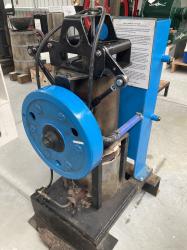

Gas or wood fired beta, 190mm bore, 87mm stroke, 2.47 litre swept volume.
The LSM 18 series has been built to investigate working fluid (air in this case) transfer. They can be configured with different linkage systems (including the conventional 90 degree phased cranks) to enable comparative testing.
Direct crank-controlled Stirling engines transfer 50% or more of their working fluid (air in this case) from the hot space to the cold before expansion is completed, cooling it even as it is expanding against the piston to make power. This is true for alpha engines such as 17.2, Whispergens and Riders, and betas such as LSM 14.1, Ericssons and Heinricis. Simple crank beta layout Stirling engines have excellent cold to hot transfer but poor hot to cold. They probably work as well as they do because getting heat out is more difficult than getting heat in- by about 3/1 as a rule of thumb.
15-4 uses a star linkage to actuate the piston and displacer. It runs great and seems to have better working fluid transfer than direct crank control (by the visuals anyway).
18.1 used a crank controlled piston while the displacer was actuated by a variant of the Whitworth quick return linkage. A section of its scotch yoke is curved rather than straight which caused the displacer to follow the piston up for all the power stroke, then return down rapidly to transfer almost all the air from the hot space to the cold before the piston begins its compression (cooling) stroke. Heated air remained in the heated space for almost the entire expansion stroke. However, comparative tests against crank control of piston and displacer showed slower starting, less power- and it required more heat.
On the possibility that this result was because of the high mechanical loads inherent in the Whitworth motion, 16 was then configured (16.4) with a linkage system that almost matched the Whitworth curved slot but with less friction and lower mechanical loads. Unfortunately. it also proved to have worse performance than the same engine with simple crank control.
This prompted a review of what effective air transfer actually looks like- using more parameters than just expansion. 18.2 is the first fruit of this re-evaluation. All its parameters are within the range established by high output LSM engines while 40% more air remains in the hot space during expansion than for simple crank control. First test is promising: by far the quickest start-up, runs on less heat than any other LSM engine and revs freely. Dynamometer testing will show whether it really is better.
The parameters used for developing the 18.2 linkage were:
* The percentage of working fluid in the expansion space at Displacer bottom dead centre (the only parameter considered in earlier attempts). Smaller is better.
* Maximum volume between the Displacer and Piston as a percentage of swept volume. 120% appears to be desirable- bigger is better.
* Ratio of maximum volume to minimum volume- compression ratio (CR). There seems to be some optimum between 2.5 and 3.5 (for nominal CR- actual will always be less because of clearance volumes) but this will likely vary depending how effective heat transfer is and the attained temperature excursion.
* Phase angle between the Displacer and Piston (Displacer leads) at Piston BDC no more than 90degrees, preferably 75 to 85?
* Phase angle between the Displacer and Piston at Piston TDC. No less than 60 degrees, preferably 70 degrees or above.
I’m sure there are other parameters that are significant, especially those around cold to hot and hot to cold transfer.
The approach I used for 18.2 was to record all these parameters for the various LSM engines and try to better the numbers for the better performers while staying clear of the numbers for the dogs. This seems to have worked, but I doubt 18.2 is anywhere near optimal yet.
PETER LYNN, ASHBURTON, NEW ZEALAND, November 2025.

LSM 18.2 with linkages for better air transfer